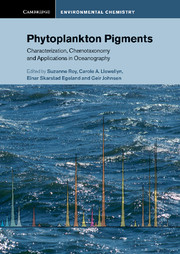Book contents
- Frontmatter
- Contents
- Contributors
- Preface
- Acknowledgements
- Abbreviations and symbols
- Part I Chlorophylls and carotenoids
- Part II Methodology guidance
- Part III Water-soluble ‘pigments’
- Part IV Selected pigment applications in oceanography
- 11 Pigments and photoacclimation processes
- 12 Pigment-based measurements of phytoplankton rates
- 13 In vivo bio-optical properties of phytoplankton pigments
- 14 Optical monitoring of phytoplankton bloom pigment signatures
- Part V Future perspectives
- Part VI Aids for practical laboratory work
- Part VII Data sheets aiding identification of phytoplankton carotenoids and chlorophylls
- Index
- Plate Section
- References
12 - Pigment-based measurements of phytoplankton rates
Published online by Cambridge University Press: 05 March 2012
- Frontmatter
- Contents
- Contributors
- Preface
- Acknowledgements
- Abbreviations and symbols
- Part I Chlorophylls and carotenoids
- Part II Methodology guidance
- Part III Water-soluble ‘pigments’
- Part IV Selected pigment applications in oceanography
- 11 Pigments and photoacclimation processes
- 12 Pigment-based measurements of phytoplankton rates
- 13 In vivo bio-optical properties of phytoplankton pigments
- 14 Optical monitoring of phytoplankton bloom pigment signatures
- Part V Future perspectives
- Part VI Aids for practical laboratory work
- Part VII Data sheets aiding identification of phytoplankton carotenoids and chlorophylls
- Index
- Plate Section
- References
Summary
The most direct way to measure phytoplankton growth/production rate is to quantify changes in biomass over a period of time, something difficult to achieve methodologically in nature. A second and serious problem is the choice of the biomass unit for measurements. Many different macromolecules have been suggested (e.g. proteins, nucleic acids, ATP, lipids and pigments). However, carbon (C) is commonly the standard unit for biomass and the desired currency for productivity models (MacIntyre et al., 2000). Because carbon is common to all organisms, estimation of phytoplankton rates based on carbon measurement is not straightforward. Among macromolecules, pigments are specific to phytoplankton. Their specificity and distinct optical properties make pigments a useful tool for studying phytoplankton processes.
Phytoplankton dynamics reflect the balance between production and losses, notably through population growth and grazing. It is, however, difficult to determine these rates simultaneously, and significant differences can be observed in the short term (hours, days), on the scale of phytoplankton generation times. Active growth is accompanied by a parallel grazing pressure exercised mostly by microzooplankton. This chapter reviews the pigment-based methods used to measure both production and grazing rates, focusing on incubation-dependent methods: the 14C-pigment labeling technique and the serial dilution bioassay. Finally we will briefly comment on other approaches such as satellite imagery and fast repetition rate fluorometry (FRRF), which are free of incubation-derived artifacts.
- Type
- Chapter
- Information
- Phytoplankton PigmentsCharacterization, Chemotaxonomy and Applications in Oceanography, pp. 472 - 495Publisher: Cambridge University PressPrint publication year: 2011
References
- 3
- Cited by



